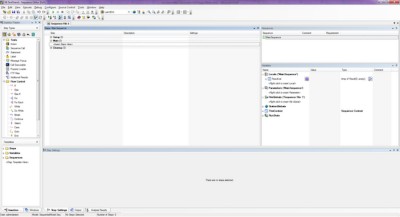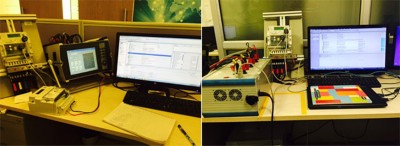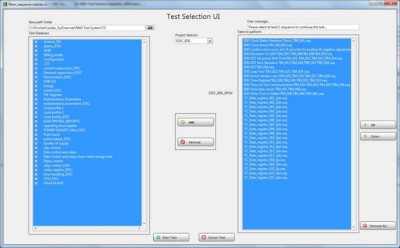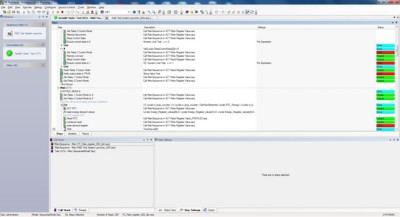Smart Meter Validation Test Bench
Himanshu Goyal, Landis+Gyr

"The energy meter automatic test bench we developed using NI software is a reliable and consistent solution for the smart meter industry. Using this integrated solution, we can avoid the restrictions and limitations of current systems and reduce test system time and cost. We saved about 65 percent of manual effort after this smart meter test bench implementation."
- Himanshu Goyal, Landis+Gyr
The Challenge:
Designing an automated testing framework system to run functional tests for smart meter metrology validation.
The Solution:
Using TestStand software, LabVIEW software, and NI-DAQmx driver software to create a highly reliable, flexible, scalable, and powerful test automation framework to address challenges presented by manual testing.
Author(s):
Himanshu Goyal - Landis+Gyr
Ashish Purohit - Landis+Gyr
The energy meter is a critical part of the electric utility infrastructure. It does not provide a control function for the power system, but it is one of the most important elements from a monitoring and accounting standpoint. We design installed meters to standards and codes that discourage tampering and detect tampering attempts. The electricity meter must be accurate and dependable, maintaining its performance in spite of environmental and electrical stresses.
Metering system validation, if carried out correctly, reduces exposure to commercial risk created over time by possible over- or under-metering total energy. Some believe that modern fiscal standard metering systems are “fit and forget” black box systems. Metering systems include many separate measurement elements, all of which are susceptible to calibration drift and measurement bias over time.
During development cycles, we need to repeat firmware tests to ensure quality. Every time we modify the source code, we must execute test cases. Manually executing test cases can be costly, time consuming, and prone to error. After analyzing these facts, we designed a system for energy meter validation. In our testing system, we address most of the existing system limitations and drawbacks of current running test benches and applications. We used TestStand software to create a common test bench to validate all energy meter utilization, instantaneous energy parameters, communication topology, security, and tampering.

Validating Energy Meters with a Test Automation Platform Based on NI Products
Major test benches and applications have some restrictions and limitations. We developed a platform using TestStand and LabVIEW software to validate utility meters and functionality, and address these restrictions and limitations.
TestStand industry-standard test management software helps in building and deploying automated test systems faster. TestStand includes a ready-to-run test sequence engine that supports multiple test code languages, flexible result reporting, and parallel/multithreaded test.
We developed various test modules to validate the different functional points in Table 1.


We have created an automated test system to test energy meters, as shown in Figure 2. We power the meters with the reference source and control the meters with an application we developed using LabVIEW visa toolkit. The system automatically runs the test sequence by providing variations in input parameters. We developed all the device drivers and DLLs for external hardware and DLMS protocol for smart metering on the LabVIEW platform.

The panel tester can select projects based on tester selection, as shown in Figure 3. The tester can view all test cases module wise in the test database section on the left. The tester can add and remove test cases in the tests to perform section. Using this panel, the user can start/abort test on UUT, change priority of test cases, remove all test cases, and more.
During execution, the tester can see test step result status in terms of pass/fail or done. All step result data is stored in a database for report generation and future analysis or reporting purposes.
We used LabVIEW to create a report generation tool in which users can choose from many criteria, and based on user selection, the tool establishes the connection with a database to get the test result data. Users can view detailed reports or step reports. Users can view test results based on firmware version selection, start and end date, and more.



The report generation tool includes many advanced features like generating reports in Excel or Word, saving reports to a local desktop, print, email, and file import/export.
The table shows the time-based effort calculation after implementing the smart meter validation test bench.
This excludes a few modules with current running automation test bench like LED, security, display, and more.
Conclusion
The energy meter automatic test bench we developed using NI software is a reliable and consistent solution for the smart meter industry. Using this integrated solution, we can avoid the restrictions and limitations of current systems and reduce test system time and cost. We saved about 65 percent of manual effort after this smart meter test bench implementation. This automated test bench can help metering industries improve their existing test systems and meets the future challenges of the changing metering industry in smart metering implementation.
Author Information:
Himanshu Goyal
Landis+Gyr
C-48, Sector-57
Noida-201301
India
Tel: +91-120-6152000, EXT: 2405
Fax: +91-120-3352001
himanshu.goyal@landisgyr.com
